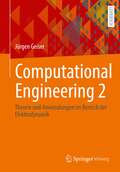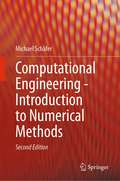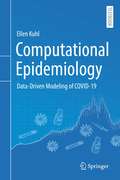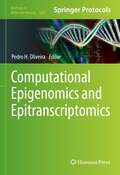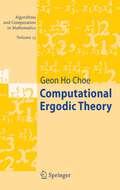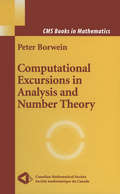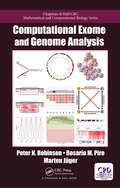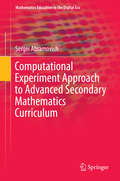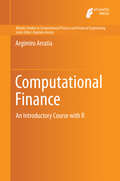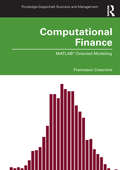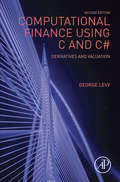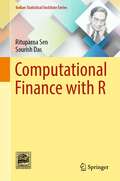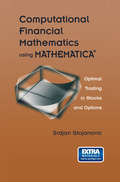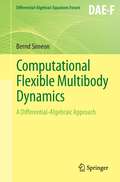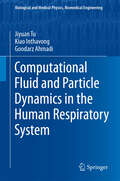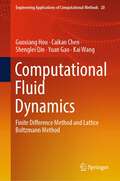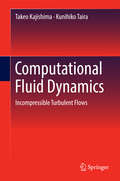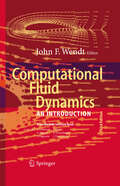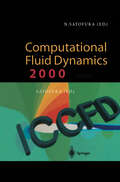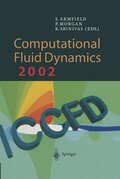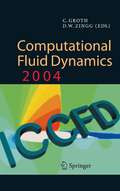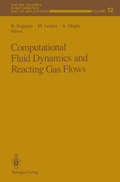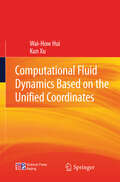- Table View
- List View
Computational Engineering 2: Theorie und Anwendungen im Bereich der Elektrodynamik
by Jürgen GeiserDas Buch zeigt Theorie und praktische Anwendungen im Bereich des Computational Engineering (berechnendes Ingenieurwesen) für elektrodynamische Anwendungen. Es illustriert sowohl die mathematischen Modelle wie auch die zugehörigen Simulationsmethoden für die verschiedenen Ingenieursanwendungen. Außerdem präsentiert es Strategien zur Verbesserung der numerischen Methoden wie z. B. Zeit-Raum-Verfahren, hyperbolische Löser, Multiskalenlöser oder strukturerhaltende Verfahren sowie Kopplungsverfahren für elektrodynamische und hydrodynamische Modelle auf verschiedenen Zeit- und Raumskalen. Dabei werden Ansätze zur Zerlegung in einfachere und effizient lösbare Teilprobleme vorgestellt. Gerade im Bereich der Multikomponenten- und Multiskalenmodelle bei komplizierten Ingenieursproblemen sind solche neuartigen Multiskalenverfahren wichtig. Weiter werden auch stochastische Modelle im Bereich der Partikelmodelle und deren Einbindung in deterministische Modelle besprochen. Diese neueren Problemstellungen brauchen iterative Löser zur Kopplung der verschiedenen Zeit- und Raumskalen. Die umfangreichen Beispiele aus dem Bereich der Elektrodynamik (inkl. elektromagnetische Felder, Antennenmodelle, Teilchenmodelle im Bereich der Plasmasimulation) geben dem Leser einen Überblick zu den aktuellen Themen und deren praktischer Umsetzung in spätere Simulationsprogramme.
Computational Engineering - Introduction to Numerical Methods
by Michael SchäferNumerical simulation methods in all engineering disciplines gains more and more importance.The successful and efficient application of such tools requires certain basic knowledge about the underlying numerical techniques.The text gives a practice-oriented introduction in modern numerical methods as they typically are applied in mechanical, chemical, or civil engineering. Problems from heat transfer, structural mechanics, and fluid mechanics constitute a thematical focus of the text.For the basic understanding of the topic aspects of numerical mathematics, natural sciences, computer science, and the corresponding engineering area are simultaneously important. Usually, the necessary information is distributed in different textbooks from the individual disciplines. In the present text the subject matter is presented in a comprehensive multidisciplinary way, where aspects from the different fields are treated insofar as it is necessary for general understanding. Overarching aspects and important questions related to accuracy, efficiency, and cost effectiveness are discussed.The topics are presented in an introductory manner, such that besides basic mathematical standard knowledge in analysis and linear algebra no further prerequisites are necessary. The book is suitable either for self-study or as an accompanying textbook for corresponding lectures. It can be useful for students of engineering disciplines as well as for computational engineers in industrial practice.
Computational Epidemiology: Data-Driven Modeling of COVID-19
by Ellen KuhlThis innovative textbook brings together modern concepts in mathematical epidemiology, computational modeling, physics-based simulation, data science, and machine learning to understand one of the most significant problems of our current time, the outbreak dynamics and outbreak control of COVID-19. It teaches the relevant tools to model and simulate nonlinear dynamic systems in view of a global pandemic that is acutely relevant to human health. If you are a student, educator, basic scientist, or medical researcher in the natural or social sciences, or someone passionate about big data and human health: This book is for you! It serves as a textbook for undergraduates and graduate students, and a monograph for researchers and scientists. It can be used in the mathematical life sciences suitable for courses in applied mathematics, biomedical engineering, biostatistics, computer science, data science, epidemiology, health sciences, machine learning, mathematical biology, numerical methods, and probabilistic programming. This book is a personal reflection on the role of data-driven modeling during the COVID-19 pandemic, motivated by the curiosity to understand it.
Computational Epigenomics and Epitranscriptomics (Methods in Molecular Biology #2624)
by Pedro H. OliveiraThis volume details state-of-the-art computational methods designed to manage, analyze, and generally leverage epigenomic and epitranscriptomic data. Chapters guide readers through fine-mapping and quantification of modifications, visual analytics, imputation methods, supervised analysis, and integrative approaches for single-cell data. Written in the highly successful Methods in Molecular Biology series format, chapters include introductions to their respective topics, lists of the necessary materials and reagents, step-by-step, readily reproducible laboratory protocols, and tips on troubleshooting and avoiding known pitfalls. Cutting-edge and thorough, Computational Epigenomics and Epitranscriptomics aims to provide an overview of epiomic protocols, making it easier for researchers to extract impactful biological insight from their data.
Computational Ergodic Theory (Algorithms and Computation in Mathematics #13)
by Geon Ho ChoeErgodic theory is hard to study because it is based on measure theory, which is a technically difficult subject to master for ordinary students, especially for physics majors. Many of the examples are introduced from a different perspective than in other books and theoretical ideas can be gradually absorbed while doing computer experiments. Theoretically less prepared students can appreciate the deep theorems by doing various simulations. The computer experiments are simple but they have close ties with theoretical implications. Even the researchers in the field can benefit by checking their conjectures, which might have been regarded as unrealistic to be programmed easily, against numerical output using some of the ideas in the book. One last remark: The last chapter explains the relation between entropy and data compression, which belongs to information theory and not to ergodic theory. It will help students to gain an understanding of the digital technology that has shaped the modern information society.
Computational Excursions in Analysis and Number Theory (CMS Books in Mathematics)
by Peter BorweinThis introduction to computational number theory is centered on a number of problems that live at the interface of analytic, computational and Diophantine number theory, and provides a diverse collection of techniques for solving number- theoretic problems. There are many exercises and open research problems included.
Computational Exome and Genome Analysis (Chapman & Hall/CRC Mathematical and Computational Biology)
by Peter N. Robinson Rosario Michael Piro Marten JagerExome and genome sequencing are revolutionizing medical research and diagnostics, but the computational analysis of the data has become an extremely heterogeneous and often challenging area of bioinformatics. Computational Exome and Genome Analysis provides a practical introduction to all of the major areas in the field, enabling readers to develop a comprehensive understanding of the sequencing process and the entire computational analysis pipeline.
Computational Exome and Genome Analysis (Chapman & Hall/CRC Mathematical and Computational Biology)
by Peter N. Robinson Rosario Michael Piro Marten JagerExome and genome sequencing are revolutionizing medical research and diagnostics, but the computational analysis of the data has become an extremely heterogeneous and often challenging area of bioinformatics. Computational Exome and Genome Analysis provides a practical introduction to all of the major areas in the field, enabling readers to develop a comprehensive understanding of the sequencing process and the entire computational analysis pipeline.
Computational Experiment Approach to Advanced Secondary Mathematics Curriculum (Mathematics Education in the Digital Era #3)
by Sergei AbramovichThis book promotes the experimental mathematics approach in the context of secondary mathematics curriculum by exploring mathematical models depending on parameters that were typically considered advanced in the pre-digital education era. This approach, by drawing on the power of computers to perform numerical computations and graphical constructions, stimulates formal learning of mathematics through making sense of a computational experiment. It allows one (in the spirit of Freudenthal) to bridge serious mathematical content and contemporary teaching practice. In other words, the notion of teaching experiment can be extended to include a true mathematical experiment. When used appropriately, the approach creates conditions for collateral learning (in the spirit of Dewey) to occur including the development of skills important for engineering applications of mathematics. In the context of a mathematics teacher education program, the book addresses a call for the preparation of teachers capable of utilizing modern technology tools for the modeling-based teaching of mathematics with a focus on methods conducive to the improvement of the whole STEM education at the secondary level. By the same token, using the book’s pedagogy and its mathematical content in a pre-college classroom can assist teachers in introducing students to the ideas that develop the foundation of engineering profession.
Computational Finance: An Introductory Course with R (Atlantis Studies in Computational Finance and Financial Engineering #1)
by Argimiro ArratiaThe book covers a wide range of topics, yet essential, in Computational Finance (CF), understood as a mix of Finance, Computational Statistics, and Mathematics of Finance. In that regard it is unique in its kind, for it touches upon the basic principles of all three main components of CF, with hands-on examples for programming models in R. Thus, the first chapter gives an introduction to the Principles of Corporate Finance: the markets of stock and options, valuation and economic theory, framed within Computation and Information Theory (e.g. the famous Efficient Market Hypothesis is stated in terms of computational complexity, a new perspective). Chapters 2 and 3 give the necessary tools of Statistics for analyzing financial time series, it also goes in depth into the concepts of correlation, causality and clustering. Chapters 4 and 5 review the most important discrete and continuous models for financial time series. Each model is provided with an example program in R. Chapter 6 covers the essentials of Technical Analysis (TA) and Fundamental Analysis. This chapter is suitable for people outside academics and into the world of financial investments, as a primer in the methods of charting and analysis of value for stocks, as it is done in the financial industry. Moreover, a mathematical foundation to the seemly ad-hoc methods of TA is given, and this is new in a presentation of TA. Chapter 7 reviews the most important heuristics for optimization: simulated annealing, genetic programming, and ant colonies (swarm intelligence) which is material to feed the computer savvy readers. Chapter 8 gives the basic principles of portfolio management, through the mean-variance model, and optimization under different constraints which is a topic of current research in computation, due to its complexity. One important aspect of this chapter is that it teaches how to use the powerful tools for portfolio analysis from the RMetrics R-package. Chapter 9 is a natural continuation of chapter 8 into the new area of research of online portfolio selection. The basic model of the universal portfolio of Cover and approximate methods to compute are also described.
Computational Finance: MATLAB® Oriented Modeling (Routledge-Giappichelli Studies in Business and Management)
by Francesco CesaroneComputational finance is increasingly important in the financial industry, as a necessary instrument for applying theoretical models to real-world challenges. Indeed, many models used in practice involve complex mathematical problems, for which an exact or a closed-form solution is not available. Consequently, we need to rely on computational techniques and specific numerical algorithms. This book combines theoretical concepts with practical implementation. Furthermore, the numerical solution of models is exploited, both to enhance the understanding of some mathematical and statistical notions, and to acquire sound programming skills in MATLAB®, which is useful for several other programming languages also. The material assumes the reader has a relatively limited knowledge of mathematics, probability, and statistics. Hence, the book contains a short description of the fundamental tools needed to address the two main fields of quantitative finance: portfolio selection and derivatives pricing. Both fields are developed here, with a particular emphasis on portfolio selection, where the author includes an overview of recent approaches. The book gradually takes the reader from a basic to medium level of expertise by using examples and exercises to simplify the understanding of complex models in finance, giving them the ability to place financial models in a computational setting. The book is ideal for courses focusing on quantitative finance, asset management, mathematical methods for economics and finance, investment banking, and corporate finance.
Computational Finance: MATLAB® Oriented Modeling (Routledge-Giappichelli Studies in Business and Management)
by Francesco CesaroneComputational finance is increasingly important in the financial industry, as a necessary instrument for applying theoretical models to real-world challenges. Indeed, many models used in practice involve complex mathematical problems, for which an exact or a closed-form solution is not available. Consequently, we need to rely on computational techniques and specific numerical algorithms. This book combines theoretical concepts with practical implementation. Furthermore, the numerical solution of models is exploited, both to enhance the understanding of some mathematical and statistical notions, and to acquire sound programming skills in MATLAB®, which is useful for several other programming languages also. The material assumes the reader has a relatively limited knowledge of mathematics, probability, and statistics. Hence, the book contains a short description of the fundamental tools needed to address the two main fields of quantitative finance: portfolio selection and derivatives pricing. Both fields are developed here, with a particular emphasis on portfolio selection, where the author includes an overview of recent approaches. The book gradually takes the reader from a basic to medium level of expertise by using examples and exercises to simplify the understanding of complex models in finance, giving them the ability to place financial models in a computational setting. The book is ideal for courses focusing on quantitative finance, asset management, mathematical methods for economics and finance, investment banking, and corporate finance.
Computational Finance Using C and C#: Derivatives and Valuation (Quantitative Finance)
by George LevyComputational Finance Using C and C#: Derivatives and Valuation, Second Edition provides derivatives pricing information for equity derivatives, interest rate derivatives, foreign exchange derivatives, and credit derivatives. By providing free access to code from a variety of computer languages, such as Visual Basic/Excel, C++, C, and C#, it gives readers stand-alone examples that they can explore before delving into creating their own applications. It is written for readers with backgrounds in basic calculus, linear algebra, and probability. Strong on mathematical theory, this second edition helps empower readers to solve their own problems. *Features new programming problems, examples, and exercises for each chapter. *Includes freely-accessible source code in languages such as C, C++, VBA, C#, and Excel.. *Includes a new chapter on the history of finance which also covers the 2008 credit crisis and the use of mortgage backed securities, CDSs and CDOs. *Emphasizes mathematical theory.Features new programming problems, examples, and exercises with solutions added to each chapterIncludes freely-accessible source code in languages such as C, C++, VBA, C#, Excel,Includes a new chapter on the credit crisis of 2008Emphasizes mathematical theory
Computational Finance with R (Indian Statistical Institute Series)
by Rituparna Sen Sourish DasThis book prepares students to execute the quantitative and computational needs of the finance industry. The quantitative methods are explained in detail with examples from real financial problems like option pricing, risk management, portfolio selection, etc. Codes are provided in R programming language to execute the methods. Tables and figures, often with real data, illustrate the codes. References to related work are intended to aid the reader to pursue areas of specific interest in further detail. The comprehensive background with economic, statistical, mathematical, and computational theory strengthens the understanding. The coverage is broad, and linkages between different sections are explained. The primary audience is graduate students, while it should also be accessible to advanced undergraduates. Practitioners working in the finance industry will also benefit.
Computational Financial Mathematics using MATHEMATICA®: Optimal Trading in Stocks and Options
by Srdjan StojanovicGiven the explosion of interest in mathematical methods for solving problems in finance and trading, a great deal of research and development is taking place in universities, large brokerage firms, and in the supporting trading software industry. Mathematical advances have been made both analytically and numerically in finding practical solutions. This book provides a comprehensive overview of existing and original material, about what mathematics when allied with Mathematica can do for finance. Sophisticated theories are presented systematically in a user-friendly style, and a powerful combination of mathematical rigor and Mathematica programming. Three kinds of solution methods are emphasized: symbolic, numerical, and Monte-- Carlo. Nowadays, only good personal computers are required to handle the symbolic and numerical methods that are developed in this book. Key features: * No previous knowledge of Mathematica programming is required * The symbolic, numeric, data management and graphic capabilities of Mathematica are fully utilized * Monte--Carlo solutions of scalar and multivariable SDEs are developed and utilized heavily in discussing trading issues such as Black--Scholes hedging * Black--Scholes and Dupire PDEs are solved symbolically and numerically * Fast numerical solutions to free boundary problems with details of their Mathematica realizations are provided * Comprehensive study of optimal portfolio diversification, including an original theory of optimal portfolio hedging under non-Log-Normal asset price dynamics is presented The book is designed for the academic community of instructors and students, and most importantly, will meet the everyday trading needs of quantitatively inclined professional and individual investors.
Computational Flexible Multibody Dynamics: A Differential-Algebraic Approach (Differential-Algebraic Equations Forum)
by Bernd SimeonThis monograph, written from a numerical analysis perspective, aims to provide a comprehensive treatment of both the mathematical framework and the numerical methods for flexible multibody dynamics. Not only is this field permanently and rapidly growing, with various applications in aerospace engineering, biomechanics, robotics, and vehicle analysis, its foundations can also be built on reasonably established mathematical models. Regarding actual computations, great strides have been made over the last two decades, as sophisticated software packages are now capable of simulating highly complex structures with rigid and deformable components. The approach used in this book should benefit graduate students and scientists working in computational mechanics and related disciplines as well as those interested in time-dependent partial differential equations and heterogeneous problems with multiple time scales. Additionally, a number of open issues at the frontiers of research are addressed by taking a differential-algebraic approach and extending it to the notion of transient saddle point problems.
Computational Fluid and Particle Dynamics in the Human Respiratory System (Biological and Medical Physics, Biomedical Engineering)
by Jiyuan Tu Kiao Inthavong Goodarz AhmadiTraditional research methodologies in the human respiratory system have always been challenging due to their invasive nature. Recent advances in medical imaging and computational fluid dynamics (CFD) have accelerated this research. This book compiles and details recent advances in the modelling of the respiratory system for researchers, engineers, scientists, and health practitioners. It breaks down the complexities of this field and provides both students and scientists with an introduction and starting point to the physiology of the respiratory system, fluid dynamics and advanced CFD modeling tools. In addition to a brief introduction to the physics of the respiratory system and an overview of computational methods, the book contains best-practice guidelines for establishing high-quality computational models and simulations. Inspiration for new simulations can be gained through innovative case studies as well as hands-on practice using pre-made computational code. Last but not least, students and researchers are presented the latest biomedical research activities, and the computational visualizations will enhance their understanding of physiological functions of the respiratory system.
Computational Fluid Dynamics: Finite Difference Method and Lattice Boltzmann Method (Engineering Applications of Computational Methods #20)
by Guoxiang Hou Caikan Chen Shenglei Qin Yuan Gao Kai WangThis book provides a concise and comprehensive introduction to several basic methods with more attention to their theoretical basis and applications in fluid dynamics. Furthermore, some new ideas are presented in this book, for example, a method to solve the transition matrix by difference operator transformation. For this method, the book gives the definition of Fourier integral transformation of translation operator, and proves the transition matrix equaling to the differential operator transformation, so that it is extended to general situations of explicit, implicit, multi-layer difference equations, etc. This flexible approach is also used in the differential part. In addition, the book also includes six types of equivalent stability definitions in two ways and deeply analyzes their errors, stabilities and convergences of the difference equations. What is more important, some new scientific contributions on lattice Boltzmann method (LBM) in recent years are presented in the book as well. The authors write the book combining their ten years teaching experience and research results and this book is intended for graduate students who are interested in the area of computational fluid dynamics (CFD). Authors list some new research achievements, such as simplified lattice Boltzmann method, the simplified lattice Boltzmann flux solver and discrete unified gas kinetic scheme, and expect that this new information could give readers possible further investigating ideas in their future research on CFD area.
Computational Fluid Dynamics: Incompressible Turbulent Flows
by Takeo Kajishima Kunihiko TairaThis textbook presents numerical solution techniques for incompressible turbulent flows that occur in a variety of scientific and engineering settings including aerodynamics of ground-based vehicles and low-speed aircraft, fluid flows in energy systems, atmospheric flows, and biological flows. This book encompasses fluid mechanics, partial differential equations, numerical methods, and turbulence models, and emphasizes the foundation on how the governing partial differential equations for incompressible fluid flow can be solved numerically in an accurate and efficient manner. Extensive discussions on incompressible flow solvers and turbulence modeling are also offered. This text is an ideal instructional resource and reference for students, research scientists, and professional engineers interested in analyzing fluid flows using numerical simulations for fundamental research and industrial applications.
Computational Fluid Dynamics: An Introduction
by John F. WendtComputational Fluid Dynamics: An Introduction grew out of a von Karman Institute (VKI) Lecture Series by the same title ?rst presented in 1985 and repeated with modi?cations every year since that time. The objective, then and now, was to present the subject of computational ?uid dynamics (CFD) to an audience unfamiliar with all but the most basic numerical techniques and to do so in such a way that the practical application of CFD would become clear to everyone. A second edition appeared in 1995 with updates to all the chapters and when that printing came to an end, the publisher requested that the editor and authors consider the preparation of a third edition. Happily, the authors received the request with enthusiasm. The third edition has the goal of presenting additional updates and clari?cations while preserving the introductory nature of the material. The book is divided into three parts. John Anderson lays out the subject in Part I by ?rst describing the governing equations of ?uid dynamics, concentrating on their mathematical properties which contain the keys to the choice of the numerical approach. Methods of discretizing the equations are discussed and transformation techniques and grids are presented. Two examples of numerical methods close out this part of the book: source and vortex panel methods and the explicit method. Part II is devoted to four self-contained chapters on more advanced material. Roger Grundmann treats the boundary layer equations and methods of solution.
Computational Fluid Dynamics 2000: Proceedings of the First International Conference on Computational Fluid Dynamics, ICCFD, Kyoto, Japan, 10–14 July 2000
by Nobuyuki SatofukaThese proceedings contain a selection of refereed contributions as a source of reference for all those interested in the state of the art in computational fluid dynamics. The conference brings together physicists, mathematicians and engineers to review and share recent advances in the field.
Computational Fluid Dynamics 2002: Proceedings of the Second International Conference on Computational Fluid Dynamics, ICCFD, Sydney, Australia, 15–19 July 2002
by Steve Armfield P. Morgan Karkenahalli SrinivasWe are pleased to present the Proceedings of the Second International Conference on Computational Fluid Dynamics held at the University of Sydney, Australia, from July 15 to 19, 2002. The conference was a productive meeting of scientists, mathematicians and engineers involved in the computation of fluid flow. Keynote lectures were presented in the areas of optimisation, algorithms, turbulence and bio-fluid mechanics. Two hundred and fifty abstracts from many countries were received for con sideration. The executive committee, consisting of A. Lerat, M. Napolitano, J.J. Chattot, N. Satofuka and myself, were responsible for the selection of papers. Each of the members had a separate subcommittee to carry out the evaluation. One hundred and seventy papers were selected of which one hundred and fifty two were presented at the conference. All papers that appear in the proceedings have been peer reviewed by a panel of experts (with a minimum of two for every paper) before publication. The conference was attended by 160 delegates with a minimum of late with drawals. The informal and friendly atmosphere provided by the university sur roundings was highly appreciated, and the technical aspects of the conference were stimulating. It is appropriate here to thank Alain Lerat, the retiring secretary of the international scientific committee of the conference. We also wish to welcome J. J. Chattot who is the incoming secretary.
Computational Fluid Dynamics 2004: Proceedings of the Third International Conference on Computational Fluid Dynamics, ICCFD3, Toronto, 12-16 July 2004
by Clinton Groth David W. ZinggThose interested in state of the art in computational fluid dynamics will find this publication a valuable source of reference. The contributions are drawn from The International Conference on Computational Fluid Dynamics (ICCFD) held in 2004. The conference is staged every two years and brings together physicists, mathematicians and engineers who review and share recent advances in mathematical and computational techniques for modeling fluid dynamics.
Computational Fluid Dynamics and Reacting Gas Flows (The IMA Volumes in Mathematics and its Applications #12)
This IMA Volume in Mathematics and its Applications COMPUTATIONAL FLUID DYNAMICS AND REACTING GAS FLOWS is in part the proceedings of a workshop which was an integral part of the 1986-87 IMA program on SCIENTIFIC COMPUTATION. We are grateful to the Scientific Committee: Bjorn Engquist (Chairman), Roland Glowinski, Mitchell Luskin and Andrew Majda for planning and implementing an exciting and stimulating year-long program. We especially thank the Workshop Organizers, Bjorn Engquist, Mitchell Luskin and Andrew Majda, for organizing a workshop which brought together many of the leading researchers in the area of computational fluid dynamics. George R. Sell Hans Weinberger PREFACE Computational fluid dynamics has always been of central importance in scientific computing. It is also a field which clearly displays the essential theme of interaction between mathematics, physics, and computer science. Therefore, it was natural for the first workshop of the 1986- 87 program on scientific computing at the Institute for Mathematics and Its Applications to concentrate on computational fluid dynamics. In the workshop, more traditional fields were mixed with fields of emerging importance such as reacting gas flows and non-Newtonian flows. The workshop was marked by a high level of interaction and discussion among researchers representing varied "schools of thought" and countries.
Computational Fluid Dynamics Based on the Unified Coordinates
by Wai-How Hui Kun Xu"Computational Fluid Dynamics Based on the Unified Coordinates" reviews the relative advantages and drawbacks of Eulerian and Lagrangian coordinates as well as the Arbitrary Lagrangian-Eulerian (ALE) and various moving mesh methods in Computational Fluid Dynamics (CFD) for one- and multi-dimensional flows. It then systematically introduces the unified coordinate approach to CFD, illustrated with numerous examples and comparisons to clarify its relation with existing approaches. The book is intended for researchers, graduate students and practitioners in the field of Computational Fluid Dynamics. Emeritus Professor Wai-Hou Hui and Professor Kun Xu both work at the Department of Mathematics of the Hong Kong University of Science & Technology, Hong Kong, China.
